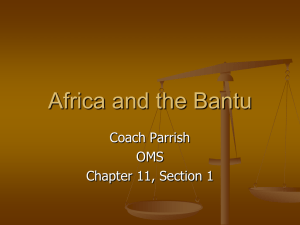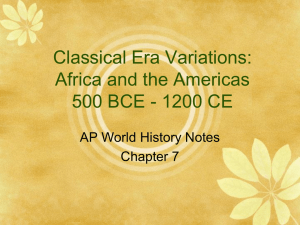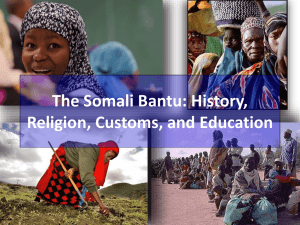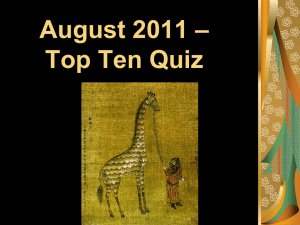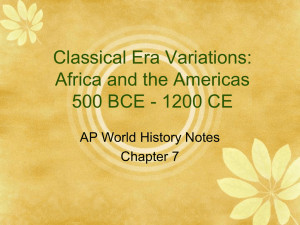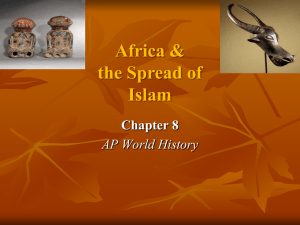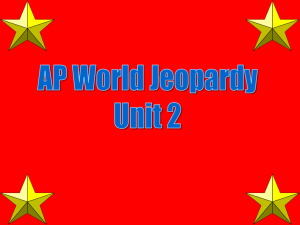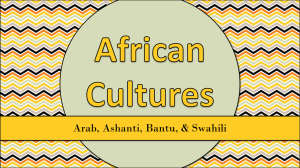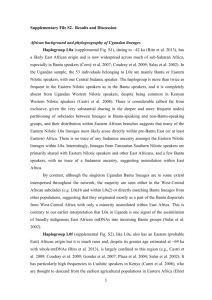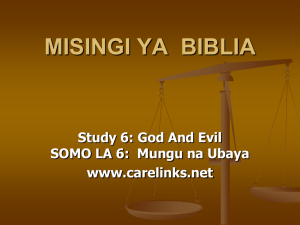The Niger-Congo Languages
advertisement
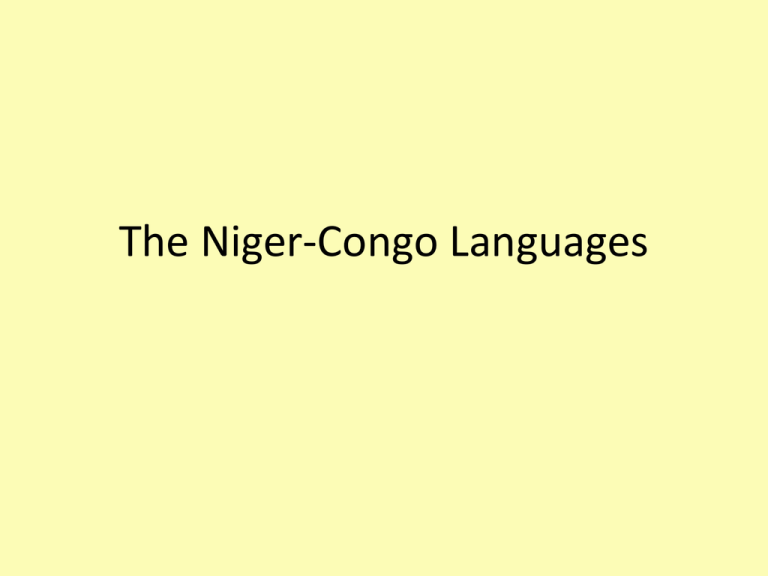
The Niger-Congo Languages General Information • According to Ethnoloque 1,532 languages • → largest phylum in the world • Occupies larger area than any other African phylum • subclassifications has been continuously modified – large number of languages – inaccessibility of much of the data – lack of able researchers Classification 1 Kordofanian • Kordofanian as fist branch →lexical evidence for uniting with Niger-Congo languages is poor • Kordofanian are most poorly documented languages within Niger-Congo • Small languages • Spoken in Nuba mountains (Rep. of Sudan) • Many have been replace by political insecurity •Greenberg: 5 groups of languages, grouped together as Kordofanian assigned them to Niger-Congo •Schadeberg (1981c) removed Kadugli-Krongo/Kadu from Kordofanian, added it to NiloSaharian → 4 remaining groups classified by Schadeberg (1989) Schadeberg showed that the noun class affixed correspond in a regular way to those of the rest of Niger-Congo Schadeberg (1989) 2 Mande •Extend over greater part of the western half of West Africa (Mali, Côte d'Ivoire, Guinea, Sierra Leone, Liberia, also in Burkina Faso, Senegal, Gambia, Guinea Bissau, Mauretania, Benin, Ghana, Togo, Nigeria) •10 to 12 million speakers •Over 50% speak Manding •Most classifications based on lexicostatistics → problems pointed out by Kastenholz (1991/2) → studied lexical innovations to gain improved classification • Mande as part of Niger-Congo • Dwyer(1998): Excamination of 603 comparative lexical entries →leads to table of cognates From: Dwyer.(1998) The place of Mande in Niger-Congo. In: Language History and Linguistic Description in Africa. Maddison, Hinnebush (Editors.). Niger-Congo Cognate Types: Total Set examined: Probable cognates: Likely cognates: Possible cognates: 603 187 124 128 Conclusion: • Western Nigrit, Benue-Congo and Mande are lexically related →lexical coherence 3 Atlantic • (West-Atlantic in Westermann’s classification) • Spoken along Atlantic coastline of West Africa • Largest languages: – Fulfulde (several million speakers) – Wolof (2 million speakers) – Diola (400,000 speakers) – Serer (600,000 speakers) – Temne (600,000 speakers) • Classification by Sapir (1971) based on lexicostatistics • Three-way division: Northern, Southern, Bijago 4 Ijoid • Small family, only spoken in Niger Delta • Languages: – Defaka (endangered), – Ijo - language cluster with over one million speakers • Closely related internally, very distinct from other NigerCongo languages 5 Dogon • About half a million speakers in Mali & Burkina Faso • Often referred as single language • Bertho (1953) proposed at least 4 languages Calame-Griaule (1978) list 5 groups of dialects • Ethnologue: 14 Dialects 6 Volta-Congo 6.1 West Volta-Congo • Contains three families: Kru, Gur, Adamawa-Ubangi • • • • • • • 6.1.1 Kru Spoken in the south-west quadrant of Côte d'Ivoire, greater part of Liberia Between 1 and 2 million speakers Main division: East and West-Kru First classified within Kwa (Westermann (1927) and Greenberg (1963)) Bennett and Sterk (1977) suggested is as part of North/West Volta-Congo Body of Kru languages are closely related Additionally three Kru isolates: Kuwaa (north-west) Tiegba & Abrako (from Aizi group) (east), Sεmε (north) • • • • • 6.1.2 Gur Very large family Spoken in south of Mali, northern parts of Côte d'Ivoure, Ghana, Togo, Benin, Burkina Faso, Nigeria About 5,5 million speakers at least 1,7mio speak Mõõre Relationship of the body is quiet clear Membership of others is more doubtful • • • • • 6.1.3 Adamawa-Ubangi Extend from north-west Nigeria through northern Cameroon, southern Chad, Central African Republic northern Gabon, Congo, Democratic Republic of Congo, south-west Sudan about 1,5 million speakers of Adamawa 2,3 million speakers of Ubangi Greenberg (1963a) divided Adamawa into 14 groups, "Eastern" into 8 groups Bennett added group 3 (containing Daka) to BenueCongo 6.2 East Volta-Congo • Greenberg (1963a:39) doubted the division between Kwa & Benue-Congo 6.2.1 Kwa • Spoken along Atlantic coast of West Africa, south western corner of Nigeria, south-eastern quadrant of Côte d'Ivoire • About 20 million speakers • Greenberg (1963a) divided into 8 groups, intigrated Central Togo languages into his group • Benett & Sterk (1977) reassigned Ijoid and Kru to Benue-Congo • • • • • • 6.2.2 Benue-Congo Occupy a vast area Greenberg divided into 4 branches: – Platoid – Jukunoid – Cross River – Bantoid Shimizu (1975) and Gerhardt (1989) integrated Jukunoid to Platoid Bennett and Sterk (1977) added eastern branches of Greenberg's Kwa → grouped together as "West Benue-Congo" → former "Benue-Congo" was named "East Benue-Congo" 6.2.2.1 Bantoid Term • First used by Krause in 1895 • → describing languages with similarity in vocabulary of Bantu • Guthrie (1948) used it for languages with noun class systems resembling Bantu (no regular sound correspondence) • → established “Guthrie Zones” – Standart referential scheme – Most zones not genetic groups → geographical • Present meaning goes back to Greenberg • → Bantu together with its closest relatives ("non-Bantu Bantoid") Classification • Benue-Congo working group tried to define in the 1970s and 1980s "Narrow Bantu" - the languages recognised by Guthrie as Bantu - as a subgroup of "Wide Bantu" • Blench and Williamson (1988) proposed a basic division within Bantiod is between North Bantoid (old "non-Bantu Bantiod" without Tivoid) and South Bantoid (all remaining Bantu languages) • → North Bantu consisting of Mambiloid and Dakoid • → Dakoid includes Chamba Daka • Classified by Greenberg as Adamawa, by Bennett (1983) as Benue-Congo • Blench assigned it to North Bantoid • Classification of Narrow Bantu is based on lexicostatistics → not overall agreed • Mostly agreed, that there is North-West Bantu (Zones A, B, C and parts of D) • → those languages are more distinct from the rest and one another • → ancient splits • Definition of boundaries between West and East Bantu differs a lot • Even suggestions for Central Bantu Problem with these classifications • Accept arbitrary boundaries of Guthrie • Piron (1998) presented most recent lexicostatistic classification, including samples of all Bantiod groups • Because of various problems (defective lists, inadequate or unrepresentative data) the work suggests different levels of relationships • South Bantoid appears as coherent group • Furthest Neightbor method shows a break between (Narrow) Bantu and the rest • Average method splits East and South Bantu from all the rest • → further work needed Typology and Reconstructions 1 Vowels • • • • • • • • • Niger-Congo languages often show vowel harmony Maximal systems: [+ATR] Vowels: / i e ɜ o u/ [-ATR] Vowels: / ɪ ɛ a ɔ ʊ / Some systems with only oral vowels, some with both, oral and nasalised Always fewer nasalised than oral vowels Westermann reconstructed #a #i #u for Proto-West-Sudanic → midvowels as later developments from coalescence or assimilation Steward (1998) reconstructed *i *ɪ *a *ʊ *u as oral and *i ̃̃ *ɪ ̃̃ *ã *ʊ̃̃ *ũ as nasal vowels for Proto-East Volta-Congo • Doneux (1975) even reconstructed a system of ten vowels with ATR harmony for Proto Northern Atlantic • →it is possible that Proto-Niger-Congo had ten vowels 2 Consonats • Typically five contrasting places of articulation: – – – – – Labial Dental/alveolar Palatal (incl. post-alveolar) Velar Labial-velar • Almost always voiceless and voiced plosives (often affricates) • Usually voiced implosives (except for Kordofanian, Dogon, parts of BenueCongo) • Occasionally unvoiced implosives • Often labialisation as secondary articulation • Sometimes palatalisation • Very rarely verlarisation Reconstruction • Westermann(1927): Very small consonant inventory • Mukarovsky (1976-7:37) richer one, including a series of consonants represented as Ch (might have been aspirate plosive, implosive, affricate or fricative) • Stewardt(1973): reconstructed the consonants of Proto-BantuPotou-Tano from sound correspondences – 4 series of stops – Voiceless and voiced lenis • 1993: proposed that lenis consonants were rather implosives →more promising given wide distribution of implosives in Niger-Congo • Non-implosive/implosive contrast has not been confirmed as going farther back than Proto-Potou-Tano • Possibly the voiced plosives found in daughter languages of ProtoBantu-Potou-Tano go back to voiced implosives •Steward (1973) showed regular sound correspondence between Potou-Tano and Bantu •Also possible between Proto-Ijo and Bantu 3 Noun Classes • Doubtlessly Proto-Niger-Congo must have had a grammaticalised noun-class-system – every family shows at least traces of the system • Mande as instance for exception – But initial consonant mutation in nouns suggest conditioning by earlier prefixes
